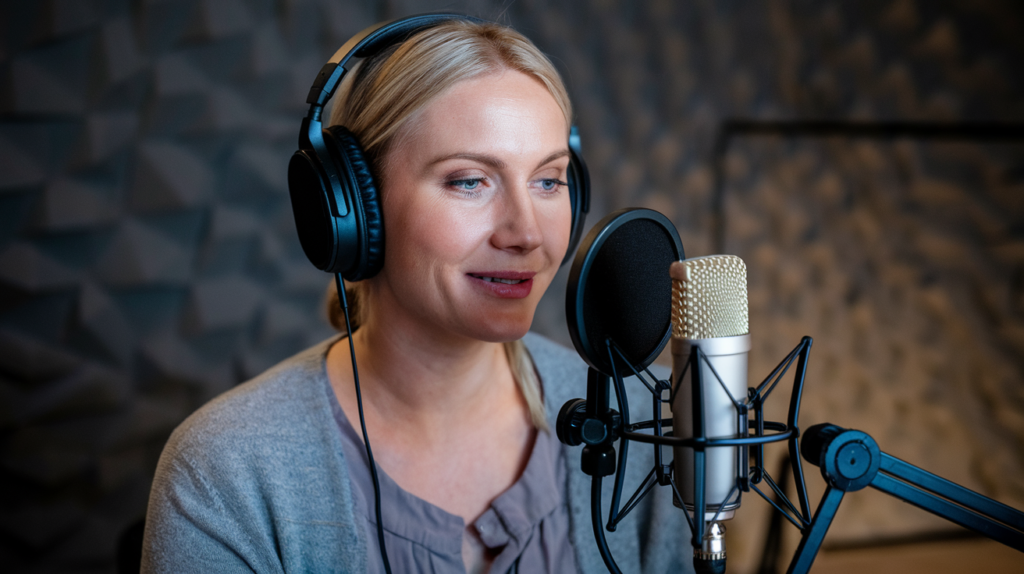Key Takeaways
- Accent Impact: Choosing between British and Australian English can significantly affect how your message resonates with audiences, influencing engagement and connection.
- Cultural Context Matters: Consider the cultural background of your audience; British accents often resonate with traditional themes while Australian accents suit contemporary narratives.
- Project Relevance: Match the accent to your project’s nature—British voices convey authority for corporate content, whereas Australian tones offer warmth for lifestyle or casual projects.
- Phonetic Differences: British English emphasizes clear enunciation, while Australian English features a relaxed vowel shift that promotes approachability in voiceovers.
- Vocabulary Variations: Be aware of distinct vocabulary differences; words may hold different meanings across dialects, impacting audience understanding and relatability.
- Audience Analysis: Tailor your accent choice based on target demographics to enhance familiarity and trust, ensuring effective communication of your message.
Ever wondered whether to choose British or Australian English for your voiceover project? The right accent can make all the difference in how your message resonates with your audience. Whether you’re aiming for a sophisticated tone or a laid-back vibe, each option brings its own unique flair.
Overview of British and Australian English
British and Australian English each bring unique qualities to the table, especially in voiceovers. Understanding these differences helps you choose the right voice talent for your project.
Accent Characteristics
British English features a range of accents, from Received Pronunciation (RP) to regional dialects like Cockney and Geordie. Each accent carries its own nuances; RP often sounds polished and formal, while regional accents can add authenticity or local flavor. This variety allows for tailored choices depending on your project’s needs.
Australian English, in contrast, tends to be more relaxed and approachable. The accent is characterized by a distinct vowel shift that gives it an easygoing feel. It’s perfect for projects aiming to connect with audiences on a casual level. If you’re looking for warmth and friendliness, an Australian voice actor might just fit the bill.
Cultural Context
When selecting between British or Australian English, consider cultural context as well. British voices may resonate more with audiences familiar with historical or traditional themes. On the other hand, Australian voices might be better suited for contemporary topics or laid-back narratives.
Project Relevance
Your choice also depends on the nature of your project. For serious corporate videos or educational content, a British voiceover artist can convey authority effectively. Conversely, if you’re producing commercials or lifestyle content aimed at younger demographics, an Australian voiceover talent could enhance relatability.
Understanding these factors ensures you make an informed decision tailored to your specific audience and message objectives in mind.
Differences Between British and Australian English
British and Australian English feature distinct differences that impact voiceover projects. Understanding these characteristics helps you choose the right accent for your audience.
Phonetic Characteristics
Phonetics significantly distinguish British from Australian English. British accents, particularly Received Pronunciation (RP), often emphasize clear enunciation and precise consonant sounds. In contrast, Australian English exhibits a noticeable vowel shift; for example, the word “mate” is pronounced with a more relaxed tone than in British contexts. This phonetic flair makes Australian accents feel approachable and friendly, suitable for casual interactions or relatable voiceovers.
Vocabulary Variations
Vocabulary also plays a crucial role in differentiating the two varieties of English. Certain words have entirely different meanings or usage in each dialect. For instance, “boot” refers to the trunk of a car in British English but means footwear in Australia. Similarly, Australians frequently use terms like “arvo” for afternoon or “biscuit” instead of cookie. These vocabulary variations affect how your message resonates with listeners, influencing their connection to the content delivered by voice actors or artists.
Importance of Accents in Voiceovers
Accents play a crucial role in voiceovers, influencing how messages resonate with different audiences. The right accent can enhance your project’s effectiveness and create a stronger connection with listeners.
Authenticity and Audience Engagement
Choosing the right accent helps establish authenticity. When you select a British or Australian English voiceover, you’re not just picking a sound; you’re also conveying cultural nuances that your audience recognizes. For instance, if your content targets an Australian demographic, an Australian accent can make your message feel more relatable and genuine.
Consider the tone you want to set. A British voice artist might evoke sophistication for luxury brands or formal presentations, while an Australian voice actor brings warmth and approachability to lifestyle products or casual narratives. This emotional connection often translates into higher engagement rates and brand loyalty.
Furthermore, accents impact how information is processed by the listener. Studies show that familiar accents tend to capture attention more effectively than unfamiliar ones. By leveraging the right dialect for your project, you invite audiences into a more immersive experience that feels tailored specifically for them.
Ultimately, understanding the significance of accents in voiceovers allows you to make informed choices that align with your project’s goals and audience expectations.
Choosing the Right Accent for Your Project
Selecting the right accent for your voiceover project is crucial. The choice impacts how effectively your message resonates with the intended audience. Different accents can evoke varying emotions and perceptions, influencing audience engagement.
Considerations for Different Genres
Different genres often call for specific accents to enhance authenticity. For corporate videos or documentaries, British English might convey authority and professionalism. In contrast, Australian English works well for lifestyle content and commercials due to its friendly, approachable tone. Think about the genre of your project—does it lean towards formal or casual? Matching the accent to the genre helps establish credibility and connection with viewers.
Target Audience Analysis
Understanding your target audience shapes your accent choice significantly. If you’re reaching a British demographic, using a British voice artist can create familiarity and trust. On the other hand, if you aim at an Australian market, an Australian voice talent makes the content feel relatable and engaging. Assessing cultural nuances in language use also plays a role; accents resonate differently based on regional preferences. Tailoring your voiceover to align with audience expectations enhances relatability and overall impact of your message.
Conclusion
Choosing between British and Australian English for your voiceover project can significantly impact how your message is received. Each accent carries its own unique charm and cultural nuances that resonate differently with audiences. By understanding the distinct qualities of both accents, you can make an informed decision that aligns with your project’s goals.
Whether you’re aiming for a sophisticated tone or a more casual vibe it’s essential to consider your target audience’s expectations. The right choice not only enhances relatability but also fosters a deeper emotional connection with listeners. Keep these factors in mind as you select the perfect voice to bring your project to life.
Frequently Asked Questions
What are the main differences between British and Australian English in voiceovers?
British English often has a sophisticated tone with clear enunciation, while Australian English is more relaxed and approachable. Each accent conveys different emotional connections, impacting how messages resonate with audiences.
When should I choose British English for voiceover projects?
Opt for British English when your project requires authority or sophistication, such as corporate videos or luxury brand promotions. The polished nature of this accent can enhance credibility and professionalism.
Why would I choose Australian English for voiceovers?
Australian English is ideal for casual, relatable content like commercials or lifestyle narratives. Its warm vibe helps connect with audiences on a personal level, fostering familiarity and engagement.
How does cultural context influence the choice of accent?
Cultural context plays a significant role; British voices may align better with traditional themes, while Australian accents suit contemporary topics. Understanding audience demographics ensures effective communication.
Can accents affect audience engagement in voiceover projects?
Yes! The right accent creates a stronger connection with listeners. Familiar accents capture attention better, leading to higher engagement rates and improved brand loyalty through emotional resonance.
What phonetic characteristics distinguish British from Australian accents?
British accents emphasize precise consonant sounds and clear enunciation. In contrast, Australian accents feature a distinct vowel shift that contributes to their easygoing feel—essential for casual interaction.
How do vocabulary differences impact message delivery between these accents?
Vocabulary variations can alter meanings or usages of certain words in each dialect. This difference affects how messages resonate; using the right terms enhances relatability with specific audiences.
What role does the tone play in choosing a voice artist’s accent?
The tone set by the voice artist significantly influences perception; British voices convey formality while Australian voices bring warmth. Selecting an appropriate tone enhances connection and aids message effectiveness.







